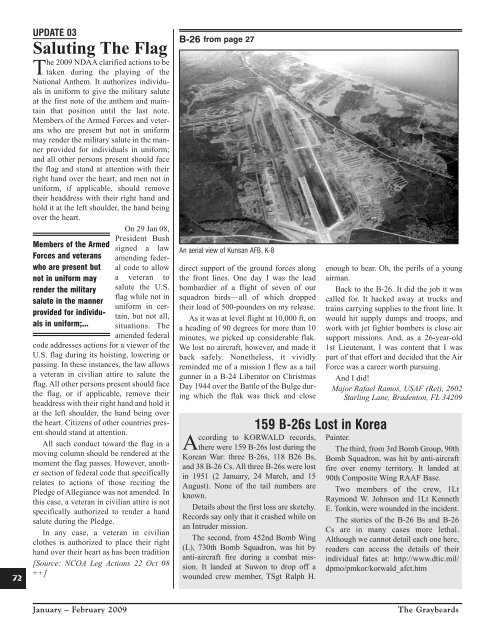Jan/Feb 2009 - Korean War Veterans Association
Jan/Feb 2009 - Korean War Veterans Association
Jan/Feb 2009 - Korean War Veterans Association
Create successful ePaper yourself
Turn your PDF publications into a flip-book with our unique Google optimized e-Paper software.
72<br />
UPDATE 03<br />
Saluting The Flag<br />
The <strong>2009</strong> NDAA clarified actions to be<br />
taken during the playing of the<br />
National Anthem. It authorizes individuals<br />
in uniform to give the military salute<br />
at the first note of the anthem and maintain<br />
that position until the last note.<br />
Members of the Armed Forces and veterans<br />
who are present but not in uniform<br />
may render the military salute in the manner<br />
provided for individuals in uniform;<br />
and all other persons present should face<br />
the flag and stand at attention with their<br />
right hand over the heart, and men not in<br />
uniform, if applicable, should remove<br />
their headdress with their right hand and<br />
hold it at the left shoulder, the hand being<br />
over the heart.<br />
On 29 <strong>Jan</strong> 08,<br />
Members of the Armed<br />
Forces and veterans<br />
who are present but<br />
not in uniform may<br />
render the military<br />
salute in the manner<br />
provided for individuals<br />
in uniform;...<br />
President Bush<br />
signed a law<br />
amending federal<br />
code to allow<br />
a veteran to<br />
salute the U.S.<br />
flag while not in<br />
uniform in certain,<br />
but not all,<br />
situations. The<br />
amended federal<br />
code addresses actions for a viewer of the<br />
U.S. flag during its hoisting, lowering or<br />
passing. In these instances, the law allows<br />
a veteran in civilian attire to salute the<br />
flag. All other persons present should face<br />
the flag, or if applicable, remove their<br />
headdress with their right hand and hold it<br />
at the left shoulder, the hand being over<br />
the heart. Citizens of other countries present<br />
should stand at attention.<br />
All such conduct toward the flag in a<br />
moving column should be rendered at the<br />
moment the flag passes. However, another<br />
section of federal code that specifically<br />
relates to actions of those reciting the<br />
Pledge of Allegiance was not amended. In<br />
this case, a veteran in civilian attire is not<br />
specifically authorized to render a hand<br />
salute during the Pledge.<br />
In any case, a veteran in civilian<br />
clothes is authorized to place their right<br />
hand over their heart as has been tradition<br />
[Source: NCOA Leg Actions 22 Oct 08<br />
++]<br />
B-26 from page 27<br />
An aerial view of Kunsan AFB, K-8<br />
direct support of the ground forces along<br />
the front lines. One day I was the lead<br />
bombardier of a flight of seven of our<br />
squadron birds—all of which dropped<br />
their load of 500-pounders on my release.<br />
As it was at level flight at 10,000 ft, on<br />
a heading of 90 degrees for more than 10<br />
minutes, we picked up considerable flak.<br />
We lost no aircraft, however, and made it<br />
back safely. Nonetheless, it vividly<br />
reminded me of a mission I flew as a tail<br />
gunner in a B-24 Liberator on Christmas<br />
Day 1944 over the Battle of the Bulge during<br />
which the flak was thick and close<br />
According to KORWALD records,<br />
there were 159 B-26s lost during the<br />
<strong>Korean</strong> <strong>War</strong>: three B-26s, 118 B26 Bs,<br />
and 38 B-26 Cs. All three B-26s were lost<br />
in 1951 (2 <strong>Jan</strong>uary, 24 March, and 15<br />
August). None of the tail numbers are<br />
known.<br />
Details about the first loss are sketchy.<br />
Records say only that it crashed while on<br />
an Intruder mission.<br />
The second, from 452nd Bomb Wing<br />
(L), 730th Bomb Squadron, was hit by<br />
anti-aircraft fire during a combat mission.<br />
It landed at Suwon to drop off a<br />
wounded crew member, TSgt Ralph H.<br />
159 B-26s Lost in Korea<br />
enough to hear. Oh, the perils of a young<br />
airman.<br />
Back to the B-26. It did the job it was<br />
called for. It hacked away at trucks and<br />
trains carrying supplies to the front line. It<br />
would hit supply dumps and troops, and<br />
work with jet fighter bombers is close air<br />
support missions. And, as a 26-year-old<br />
1st Lieutenant, I was content that I was<br />
part of that effort and decided that the Air<br />
Force was a career worth pursuing.<br />
And I did!<br />
Major Rafael Ramos, USAF (Ret), 2602<br />
Starling Lane, Bradenton, FL 34209<br />
Painter.<br />
The third, from 3rd Bomb Group, 90th<br />
Bomb Squadron, was hit by anti-aircraft<br />
fire over enemy territory. It landed at<br />
90th Composite Wing RAAF Base.<br />
Two members of the crew, 1Lt<br />
Raymond W. Johnson and 1Lt Kenneth<br />
E. Tonkin, were wounded in the incident.<br />
The stories of the B-26 Bs and B-26<br />
Cs are in many cases more lethal.<br />
Although we cannot detail each one here,<br />
readers can access the details of their<br />
individual fates at: http://www.dtic.mil/<br />
dpmo/pmkor/korwald_afct.htm<br />
<strong>Jan</strong>uary – <strong>Feb</strong>ruary <strong>2009</strong><br />
The Graybeards

















